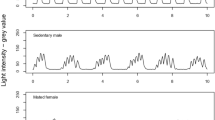Abstract
FemalePhoturis versicolor fireflies attempt to capture males by responding to heterospecific flash patterns. A mating-dependent switch occurs which affects response timing and frequency of female flashes. We examined the switch using females of known age, mating status, and flash experience to assess how accurate mimicry is, what factors influence it, and what mechanism produces it. Presentations of simulated male flash patterns before and after mating revealed elements of an entrainment mechanism controlling female responsiveness. Unmated females preferentially answered conspecific patterns with variable latencies, averaging 1 s. Mating induced changes in both response frequency and response latency: Females answered heterospecific patterns more frequently, and latencies elicited by conspecific patterns shifted away from the unmated range. Heterogeneity in mean and variance of response latency among individuals indicates that females do not share a discrete reply to a given pattern. Little correspondence exists between latencies of sympatric species andP. versicolor females, suggesting that the flash response mechanism produces entriainment to any rhythmic pattern, not a one-to-one matching between prey and predator latencies. Different selective scenarios underlie strict mimicry versus entrainment mimicry.
Similar content being viewed by others
References
Barber, H. S. (1951). North American fireflies of the genusPhoturis.Smithson. Misc. Collect. 117 1–58.
Buck, J. B. (1937). Studies on the firefly. II. The signal system and color vision inPhotinus pyralis.Physiol. Zool. 10 412–419.
Buck, J. B., and Buck, E. (1972). Photic signalling in the fireflyPhotinus greeni.Biol. Bull. 142 195–205.
Buck, J. B., and Case, J. F. (1986). Flash control and female dialog repertory in the fireflyPhotinus greeni.Biol. Bull. 170 176–197.
Buck, J. B., Buck, E., Case, J. F., and Hanson, F. E. (1981). Control of flashing in fireflies. V. Pacemaker synchronization inPteroptyx cribellata.J. Comp. Physiol. 144 287–298.
Bushman, L. B. (1974). Flash behavior of a Nova Scotian firefly,Photuris fairchildi Barber, during courtship and aggressive mimicry (Coleoptera, Lampyridae).Coleopterists Bull. 28 27–31.
Calvin, W. H., and Stevens, C. F. (1968). Synaptic noise and other sources of randomness in motorneuron interspike intervals.J. Neurophysiol. 31 574–587.
Carlson, A. D. (1981). Neural control of the malePhoturis versicolor firefly flash.J. Exp. Biol. 92 165–172.
Carlson, A. D., and Copeland, J. (1972). Photic inhibition of brain stimulated firefly flashes.Am. Zool. 12 479–487.
Carlson, A. D., and Copeland, J. (1985). Flash communication in fireflies.Q. Rev. Biol. 60 415–436.
Carlson, A. D., and Soucek, B. (1975). Computer simulation of firefly flash sequences.J. Theor. Biol. 55 353–370.
Carlson, A. D., Copeland, J., Raderman, R., and Bulloch, A. G. M. (1976). Role of interflash intervals in a firefly courtship (Photinus macdermotti).Anim. Behav. 24 786–792.
Carlson, A. D., Copeland, J., and Shaskan, R. (1982). Flash communication between the sexes of the fireflyPhoturis lucicrescens.Physiol. Entomol. 7 127–132.
Dumont, J. P. C., and Robertson, R. M. (1986). Neuronal circuits: An evolutionary perspective.Science 233 849–853.
Eberhard, W. G. (1990). Imprecision in the behavior ofLeptomorphus sp. (Diptera, Mycetophilidae) and the evolutionary origin of new behavior patterns.J. Insect Behav. 3 327–357.
Edmunds, L. E. (1963). The relationship between temperature and flashing intervals in adult male fireflies,Photinus pyralis.Ann. Entomol. Soc. Am. 56 716–718.
Hanson, F. E. (1982). Pacemaker control of rhythmic flashing of fireflies. In Carpenter, D. (ed.),Cellular Pacemakers, Vol. 2, John Wiley and Sons, New York, pp. 81–100.
Lewis, S., and Wang, O. T. (1992). Reproductive ecology of two species ofPhotinus fireflies (Coleoptera: Lampyridae).Psyche 98 293–307.
Lloyd, J. E. (1965). Aggressive mimicry inPhoturis: Fireflyfemmes fatales.Science 149 653–654.
Lloyd, J. E. (1966). Studies on the flash communication system inPhotinus fireflies.Univ. Mich. Mus. Zool. Misc. Publ. No. 130, pp. 1–96.
Lloyd, J. E. (1975). Aggressive mimicry inPhoturis fireflies: Signal repertoires byfemmes fatales.Science 187 452–453.
Lloyd, J. E. (1979). Sexual selection in luminescent beetles. In Blum, M., and Blum, N. (eds.),Sexual Selection and Reproductive Competition in Insects, Academic Press, New York, pp. 293–342.
Lloyd, J. E. (1984). On deception, a way of all flesh, and firefly signalling and systematics. In Dawkins, R., and Ridley, M. (eds.),Oxford Surveys in Evolutionary Biology, Oxford University Press, London, Vol. I, pp. 49–84.
McDermott, F. A. (1917). Observations on the light-emission of American Lampyridae.Can. Entomol. 49 53–61.
McDermott, F. A. (1958).Fireflies of Delaware, Soc. Nat. Hist. Delaware, Wilmington.
McLean, M., Buck, J., and Hanson, F. (1972). Culture and larval behavior of photurid fireflies.Am. Midl. Nat. 87 133–145.
Nelson, S., Carlson, A. D., and Copeland, J. (1975). Mating induced behavioral switch in female fireflies.Nature 225 628–629.
Soucek, B., and Carlson, A. D. (1986). Brain windows in firefly communication.J. Theor. Biol. 119 47–65.
Zorn, L. P., and Carlson, A. D. (1978). Effect of mating on response of femalePhoturis fireflies.Anim. Behav. 26 843–847.
Author information
Authors and Affiliations
Rights and permissions
About this article
Cite this article
Vencl, F.V., Blasko, B.J. & Carlson, A.D. Flash behavior of femalePhoturis versicolor fireflies (Coleoptera: Lampyridae) in simulated courtship and predatory dialogues. J Insect Behav 7, 843–858 (1994). https://doi.org/10.1007/BF01997130
Accepted:
Issue Date:
DOI: https://doi.org/10.1007/BF01997130




